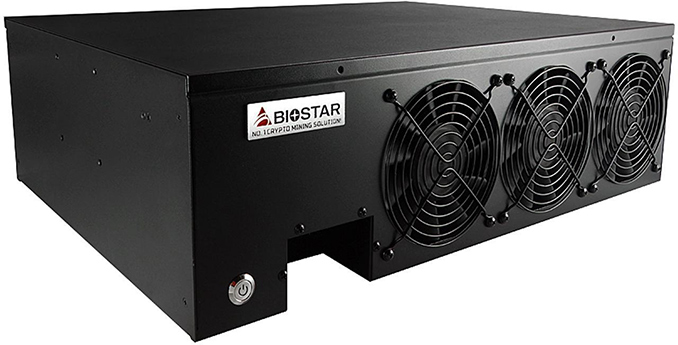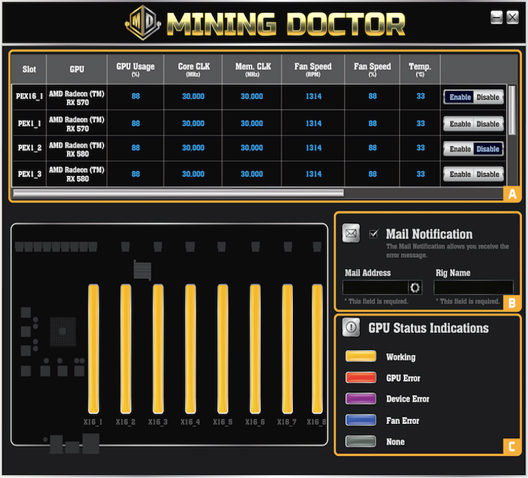Biostar’s iMiner A578X8D Crypto Mining Machine Now Available
by Anton Shilov on September 11, 2018 4:00 PM EST
Just in time for this week's dive in cryptocurrency prices, Biostar has started selling its specially designed all-in-one rig for mining. The iMiner A578X8D is a complete black box crypto mining solution for eight GPUs, and notably does not use any riser cards. As a result, the fully-integrated miner is touted as being extra-durable to ensure stable 24/7 operation and an equally stable hash rate.
The Biostar iMiner A578X8D is based on the company’s TB250-BTC D+ motherboard featuring Intel’s Celeron G3930 processor (two cores, 2.9 GHz, 51 W TDP), 4 GB of DDR4-2400 memory, and a 120 GB SSD. The system is equipped with eight AMD Radeon RX 570 graphics cards and a 1600 W PSU to provide these GPUs a stable supply of power. The crypto mining rig supports ETH, ETC, XMR, and ZEC currencies out of the box, which greatly simplifies its deployment. According to the manufacturer, one iMiner A578X8D can deliver ETH hash rate of 220 MH/s (+/- 5%).
The mining rig is outfitted with seven fans to ensure sufficient cooling. In addition, the TB250-BTC D+ motherboard has a PCIe slot state detection that can check the state of each GPU and discover whether everything works properly. If the iMiner detects an error, it automatically sends an email notification to enable remote management of the rig.
The all-in-one mining farm is now available from Newegg for $3,499. Later on the company is expected to start selling other AIO mining rigs that will pack six and 12 GPUs, thus offering a bit lower and higher performance.
| Biostar iMiner | |||||
| A564X12 | A578X6 | A578XD | |||
| Motherboard | TB250-BTC Pro | TB250-BTC D+ | |||
| CPU | Intel Celeron G3930 Dual Core 2.9 GHz 51W TDP |
||||
| Memory | 4GB DDR4-2400 | 4GB DDR4-2400 | |||
| SSD | 90GB | 120GB | |||
| Video Card(s) | 12x RX 560 4G | 6x RX 570 8G | 8x RX 570 | ||
| Power Supply | 1300W, ≥88% efficiency | 1600W, ≥88% efficiency | |||
| Chassis | Black, 5x 120mm fans | Black, 7x 120mm fans | |||
| Hashrate (ETH) | 148 MH/s (±5%) | 165 MH/s (±5%) | 220 MH/s (±5%) | ||
| Dimensions (LxWxH) | N/A | 19.8" x 13.58" x 5.84" | |||
Related Reading:











26 Comments
View All Comments
Lolimaster - Tuesday, September 11, 2018 - link
When mining gpu is dead.If I were them I would release gpu's with no fan, just a big aluminum heatsink so people can add fans from whoever vendor they want and get better cooling.
Big chunk of metal + 120mm fan is way better than those triple 85mm fans.
Dragonstongue - Tuesday, September 11, 2018 - link
damn right, a good made full aluminum heatsink per GPU would allow a crap ton of cooling compared to most of the blower style or even the vast majority of dual or triple fan "custom" coolers that blow the heat everywhere, put a slight incline on the heatsink and one or 2 heatpipes and crazy good cooling.where there is a will there is a way.
but I totally agree, to chase a "miner" now, is basically pointless, might as well just fork out the bigger bucks and go with a dedicated ASIC which buries the best of the best GPU out there at a fraction of the energy and heat output.
no wonder the Radeons are still seeing bloated pricing.
gfkBill - Tuesday, September 11, 2018 - link
The Ethereum ASIC that's been touted at this stage doesn't "bury" current GPU solutions at all. It's less efficient than a well-setup GTX1060 rig.mitchelpt - Wednesday, January 5, 2022 - link
Biostar’s new iMiner A578X8D is specifically designed for cryptocurrency mining. It has an 8-core CPU that can handle up to 8 GPU cards. This performance is optimized for mining MTP, ETH, and ZEC at the same time. Most powerful Bitcoin miner https://aicrypto.tips/what-is-the-most-powerful-bi...The Biostar A578X8D supports both AMD and NVIDIA graphics card for multi-GPU mining rigs. The motherboard comes with a built in 8x PCIe x16 slots, which can be used by up to 8 GPU cards in a single system at the same time. Furthermore, it features a 4 x PCIe x1 slots to provide video outputs from the GPU cards for all your monitors or even TV screens.
Valantar - Wednesday, September 12, 2018 - link
Your first paragraph there doesn't add up. Aren't these custom coolers mostly just massive aluminium fin arrays with heat pipes? Sure, they have small-ish fans, but that's mainly due to the requirement of fitting within a 2 (or even 3) slot thickness, card and all. Also, how would a "full aluminium heatsink" (whatever that means) not "blow the heat everywhere"? Does it include ducting? Where is the fan mounted?Also, the thermal conductivity of aluminium is garbage compared to heatpipes, so the bigger your full-metal heatsink is, the worse it'll perform compared to its size. Beyond moving heat a few cm in each direction from its source (like the standard cheapo GTX 1050 Ti-style coolers), you'd either need crazy thick aluminium (which goes against adding surface area for dissipation) or heatpipes for effective thermal transfer. The point being: beyond small sizes and low thermal loads, monolithic metal heatsinks are not good at all - there's a reason for the proliferation of "fins-threaded-on-heatpipes" designs in both the CPU and GPU space. It's far superior.
Jaybus - Wednesday, September 12, 2018 - link
It is true that ASIC-resistant algorithms are not really feasible. However, currencies certainly can fork in fairly trivial ways that nevertheless render the current ASIC useless. An updated ASIC can readily be designed to match the new algorithm, but it is cheaper and easier to install new software for the GPUs than it is to buy a new ASIC. Some currencies make it known that they will fork anytime an ASIC is released/discovered. So GPU is dead for some, but not all, currencies.kmi187 - Monday, September 17, 2018 - link
I like your idea, but I'd drop the heatsink too. Just sell bare cards with an industry standard mounting system. Then let aftermarket brands, that already make cpu coolers, have some of the cake and design some kickass GPU coolers we can all pick from. What was lost in profit would easily be offset by them being able to drop their budget on cooling R&D.Valantar - Tuesday, September 11, 2018 - link
... why?JoeyJoJo123 - Tuesday, September 11, 2018 - link
To all those asking why:They already spent possibly over a year in R&D and manufacturing this product. Sometime between the initial green light of making such a product (where gpu mining was at a high) and now, gpu mining took a steep turn down. But they're still out of several months of work on designing a product that was probably almost finished when the downturn took place. Biostar's probably well aware. They, just like many GPU manufacturers, just got burned the moment they try to spin up production or new products to meet excess mining demand, only for it to falter and then be left with a large amount of mining products that miners don't want. (This is exactly why nVidia and AMD didn't want to increase GPU production during that year or so of increased GPU demand.)
It's unfortunate for Biostar, but this product would've gotten more buyers if it had launched a while back.
Valantar - Wednesday, September 12, 2018 - link
... so a classic case of the sunk cost fallacy making people make stupid decisions, then. These probably entered volume production a month or two back, at which time crypto had already plummeted. You're of course right that the R&D must have started long before that, and preparations for production would also have been in the pipeline for a while. But the idea that they "have to" make it just because they've already spent money on R&D and preparations is silly. They're not going to recoup any costs here. Best case scenario unless crypto makes an unheard-of comeback, they break even on the production costs - but even that's unlikely. In all likelihood, they'd be better off scrapping the project wholesale (and thus eating the R&D cost) before starting production, instead of spending even more spinning up a production line and getting distribution in order for a product nobody wants.